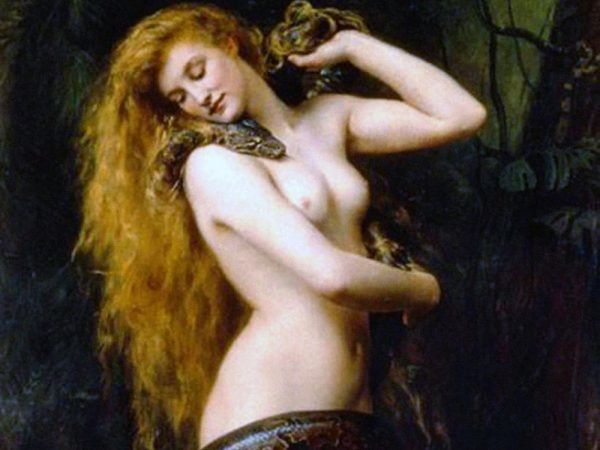Date of Discovery
Due to the Biblical origin of the first succubus, it is fair to say that the first date that the succubus appeared in literature was circa 1450 BC when the Old Testament of the bible was first composed.
Name
Known as a succubus, but often each has her own name—Lilith, the Lilin, Belili, are just but a few examples.
The male counterpart to the succubus is the incubus.
Physical Description
A succubus varies in the details of their appearance, but thematically they are young women with unearthly beauty. In some instances, they also have a combination of bat-like wings, a wealth of bosom, horns, and cloven feet—their beauty is such that their victims cannot stop thinking of them even after the attack has occurred.
Origin
The origin story of the succubus can be found with the most famous of them all—Lilith—the first wife of Adam. Her story began in the Garden of Eden and the race of demons that spawned from her unholy womb gave life to the demons we know as succubi today.
Mythology and Lore
It seems that a succubus, like any other demon, isn’t just some random entity—there is actually dedicated lore on several well-known succubi throughout history.
Lilith
In Western society, Lilith is a character represented as the first wife of Adam of Biblical times—an extremely controversial figure within Jewish folklore, she was omitted from the creation story in the Torah, instead only appearing in some of the Midrashic texts. In some of her origin stories, God created her from the dust and placed to live in the Garden of Eden with Adam. Problems arose between the two first products of creation, as believing that they were created equally from the dust of the earth, Lilith refused to allow Adam to treat her as his subordinate. When Adam disagreed, Lilith left the Garden of Eden to exercise her independence—the story of the first woman who figuratively snapped her fingers and told her lover, “you don’t own me!”

In one version of the story, Adam told God that Lilith had left the garden, so God sent Senoi, Sansenoi, and Sammangelof to retrieve her—these three angels found Lilith having children. It was then that the angels cursed her so that one hundred of her children would die every day for her disobedience. Lilith cursed humanity right back and is said to be the cause of infants being still-born, as well as SIDS.
A second version of the story is that after the angels told her to return to the Garden of Eden, she actually tried to return, but found that Adam had already been given a new wife—Eve. So out of spite, while Adam was sleeping, she molested him while he was sleeping, impregnated herself then bore the Lilin, who were earth-bound demons she used to replace her children killed by angels.
In both Arabic and Jewish myths, she isn’t the first wife of Adam, she’s just a succubus—a female demon who hunts men, seduces them, then drains their life with a kiss. Anyone who has seen Lost Girl would be able to tell where they got the inspiration for their main character Bo. In Jewish lore especially, mothers believed that Lilith would kidnap and consume their children.
Mara
The Mara is considered one of the succubi, but her function is primarily that of sucking the vitality out of people while they’re sleeping—this is also credited to the Nightmare, or sleep paralysis, which are demons who sit on the chest of their victims, sometimes choking them while they lay paralyzed.
Rusalka
Slavic folklore brings us the Rusalka—who presents as a female ghost, water nymph, or lake-bound succubus; she has fiery green eyes which she uses to seduce and lure men into her grasp, where they die in her arms. She’s comparable to the Scandinavian and German Nixie. In the spirit version of the Rusalka, she is simply the soul of a young woman who died in or near a lake, usually at the hands of her lover. The only way to rid yourself of a Rusalka is to avenge her death, at which point the spirit will move on to the next plane of existence.
Yuki-Onna
In Japanese folklore, there is the Yuki-Onna, which translates to “Snow Woman,” who is a type of female spirit who condemns travelers to death in the snow. She appears as a tall, beautiful woman, with long hair and nearly translucently pale skin, which allows her to blend into the snowy landscape.
Allu
In Akkadian mythology the Allu faceless demons that were born of Lilith or one of her demon servants. They destroy all they come across and capture, even their father, who while on his deathbed, would be robbed of his soul which would block him from ever entering the afterlife and cause him to roam the land of the living as a malevolent ghost.
Belili
Sister of Dumuzi, and wife of Nin-ghiszida, Belili is considered to be the first Sumerian goddess called Geštinanna. Geštinanna is the goddess of agriculture, fertility, and dream interpretation and was later included in the Babylonian pantheon as Belili—as the wife of Bel she is often compared with Ishtar, Astarte, and Asherah. Commonly associated with sacred prostitution and sacrificing human children, in which versions she is associated with Lilith and the demon Asmodai.
Modern Pop-Culture References
Books
The Shadow of the Succubus (2004)
Movies
Jennifer’s Body (2009)
Television Series
Lost Girl (2010 – 2016)
Is there anything we missed about Succubi? Let us know in
the comments section below!

Georgia-based author and artist, Mary has been a horror aficionado since the mid-2000s. Originally a hobby artist and writer, she found her niche in the horror industry in late 2019 and hasn’t looked back since. Mary’s evolution into a horror expert allowed her to express herself truly for the first time in her life. Now, she prides herself on indulging in the stuff of nightmares.
Mary also moonlights as a content creator across multiple social media platforms—breaking down horror tropes on YouTube, as well as playing horror games and broadcasting live digital art sessions on Twitch.

